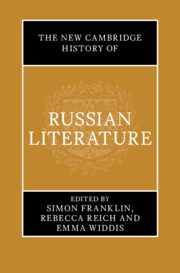Book contents
- The New Cambridge History of Russian Literature
- The New Cambridge History of Russian Literature
- Copyright page
- Contents
- Figures
- Contributors
- Acknowledgements
- On Transliteration, Names, and Dates
- Introduction
- History 1 Movements
- 1.1 The Age of Devotion
- 1.2 The Baroque Age
- 1.3 The Age of Classicism
- 1.4 Sentimentalism and Romanticism
- 1.5 The Natural School and Realism
- 1.6 Symbolism and the Fin de Siècle
- 1.7 Modernism and the Avant-Garde
- 1.8 Socialist Realism
- 1.9 Postmodernism
- 1.10 Contemporary Movements
- Boxes 1 Close Readings
- Boxes 2 Genres
- History 2 Mechanisms
- History 3 Forms
- History 4 Heroes
- Index
- References
1.7 - Modernism and the Avant-Garde
from History 1 - Movements
Published online by Cambridge University Press: 31 December 2024
- The New Cambridge History of Russian Literature
- The New Cambridge History of Russian Literature
- Copyright page
- Contents
- Figures
- Contributors
- Acknowledgements
- On Transliteration, Names, and Dates
- Introduction
- History 1 Movements
- 1.1 The Age of Devotion
- 1.2 The Baroque Age
- 1.3 The Age of Classicism
- 1.4 Sentimentalism and Romanticism
- 1.5 The Natural School and Realism
- 1.6 Symbolism and the Fin de Siècle
- 1.7 Modernism and the Avant-Garde
- 1.8 Socialist Realism
- 1.9 Postmodernism
- 1.10 Contemporary Movements
- Boxes 1 Close Readings
- Boxes 2 Genres
- History 2 Mechanisms
- History 3 Forms
- History 4 Heroes
- Index
- References
Summary
This chapter provides an introduction to Russian literature in the Modernist and avant-garde period, stretching from about 1890 to 1930. This period was one of extraordinary experimentation in Russian literature and the chapter outlines the differences between the key movements that emerged and their leading practitioners, including Symbolism (Aleksandr Blok), Futurism (Vladimir Maiakovskii, Velimir Khlebnikov), and Acmeism (Anna Akhmatova, Osip Mandelshtam). It highlights the inextricable links between literature and politics in this period, especially following the Revolution of 1917, which saw the Bolsheviks take power and establish the Soviet Union. While the early 1920s witnessed a genuine debate among writers about what the new Soviet literature would look like, this diversity vanished by the end of the decade as centralisation took hold. By the 1930s, Socialist Realism had become the only approved official aesthetic. The chapter concludes with remarks about the Modernists’ legacy within and beyond Russia.
Keywords
- Type
- Chapter
- Information
- The New Cambridge History of Russian Literature , pp. 125 - 146Publisher: Cambridge University PressPrint publication year: 2024

